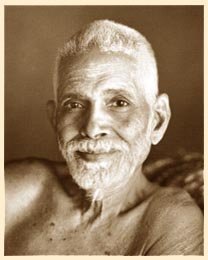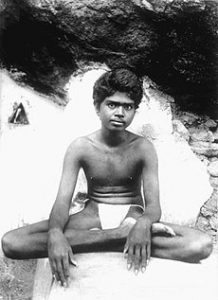
Ramana Maharshi
Ramana Maharshi – An Enlightened Being
Super Minds 4
Ramana was born on December 29th, 1879, at Tiruchuzhi in South India. His father was an uncertified pleader, which is a sort of rural lawyer, and as a child, Ramana showed no sign of his later experiences. At school he was athletic; football, wrestling and swimming being his main enjoyments. He had an amazing memory, being able to repeat a lesson once heard, but was not thought of as bright.
Just after his sixteenth birthday, however, a strange experience came to him. Sitting alone he suddenly felt a violent fear of death.
The results upon his outer life were quite marked, although he told no one of his experience. He says, “Whatever work was given, whatever teasing or annoyance there was, I would put up with it quietly. The former ego that had resented and retaliated had disappeared. I stopped going out with friends to play games, and preferred solitude. I would often sit alone especially in a posture suitable for meditation, and become absorbed in the Self, the Spirit, the force or current which constituted me.”
His everyday life suffered however, and on a remark from his brother that his home was no use to one who acted like a Yogi, he left home for Arunachala, which is a holy mountain. From this time, until his death in 1950, he stayed near or on the Holy Mountain of Arunachala. He sought no disciples and made no effort to go about preaching of his insight. For some length of time, day and night were spent in meditation, his whole consciousness immersed in that “current” of his being revealed to him earlier. For many years he did not even speak, but sat quiet and still, immersed in that he had discovered within. This did not stop others noticing the blessedness of his presence, and soon crowds would visit just to see or sit near him, even though he never spoke or seemed to notice them. As time passed however, he began to answer questions in writing, and later on began speaking again.
Later, in describing this part of his life, he said, “Sometimes I opened my eyes and it was morning, sometimes it was evening; I did not know when the sun rose or when it set.” He compared this experience with a bucket being lowered by rope into a well, and then being drawn out. In other words, the ego dips into the unconditional, but can emerge again. His eventual condition was however, like the river entering the sea. That is, the ego is now merged into the unconditional, and yet one is still aware of the physical world, and can go about normal duties without loss of that consciousness. In the first one, the ego disappears only at deeper levels of consciousness. In the second, the unconditional bliss is felt at all times, in all situations.
With the growth in number of those who came as disciples to him, he took up residence on the slopes of Arunachala itself. He still maintained silence in these early years on the Holy Hill. So why did many make the long journey up the mountain to see him? Arthur Osborne, one of Ramana’s European disciples, says, “It was not only seekers after Truth who were drawn to him but simple people, children, even animals. Young children from the town of Tiruvannamalai would climb the hill to Virupaksha Cave, sit near him, play around him, and go back feeling happy. Squirrels and monkeys would come up to him and eat out of his hand.”
Outwardly from this time on, his life is empty of the exciting events one so often meets in famous biographies, but the richness of Ramana’s life, lived in the unconditional state, was one of inner relationships with the thousands who visited him. Unless we account these inner contacts he made with those who came, his life must appear empty and uneventful. For each day was spent seated, hardly speaking, or quietly performing every-day chores as in cleaning vegetables for the day’s meal.
H. Humphreys, writing to a friend in London about Ramana, says, “On reaching the cave we sat before him at his feet and said nothing. We sat thus for a long time and I felt lifted out of myself. For half an hour I looked into the Maharshi’s eyes, which never changed their expression of deep contemplation. I began to realise somewhat that the body is the Temple of the Holy Ghost; I could feel only that his body was not the man: it was the instrument of God, merely a sitting, motionless corpse from which God was radiating terrifically. My own feelings were indescribable.”
Paul Brunton, a journalist who had visited a number of so-called Masters, and had left each one still sceptical, also visited Ramana and wrote: “It is an ancient theory of mine that one can take the inventory of a man’s soul from his eyes. But before those of the Maharshi I hesitate, puzzled and baffled.
“I cannot turn my gaze away from him. My initial bewilderment, my perplexity at being totally ignored, slowly fade away as this strange fascination begins to grip me more firmly. But it is not till the second hour of the uncommon scene that I become aware of a silent, resistless change which is taking place within my mind.”
“I know only that a steady river of quietness seems to be flowing near me, that a great peace is penetrating the inner reaches of my being, and that my thought-tortured brain is beginning to arrive at some rest.”
One of those who stayed to serve him and become a disciple, arrived with a different problem than the quest for truth or understanding. Echammal had been a happy wife and mother, but before twenty-five she lost her husband, her only son, then her only daughter. Her grief and torture were such that she could not even stay in the vicinity of her previous home. She travelled to Gokarnam to serve the holy men there, but found no respite from her agony. Returning home, friends told her that many had found peace in Ramana’s presence. Immediately she set out. She had relatives in Tiruvannamalai, but she did not visit them, knowing it would increase her suffering by reviving memories. She climbed the hill and stood before Ramana in silence, not telling her misery. For a whole hour she stood and looked. Then she turned, her burden lifted and gone. See Video of Sri Ramana
Ramana’s Meditation
People attempt to describe enlightenment in many ways. Ramana Maharshi says that when you realise the Self (enlightenment), the sense of yourself as separate from the world disappears.
Another person describes it by saying, ‘I was sitting opposite someone during an enlightenment intensive workshop. We had been posing the question for days – “Who are you?” Suddenly I realised that it was a silly question, because I was the answer. All thought then stopped and I existed as the answer. My being had always been this. In this state there was an awareness of being connected with everything around me, in the beginning of creation. This was the first day.’
Another person writes, ‘Unexpectedly everything changed and my fundamental self was something that existed throughout all time. It didn’t have a beginning or end. There was no goal to achieve. I am.’
Slightly different but still the same enlightenment. ‘Everything seemed to slip away and I felt as if I melted back into the primal being of the universe. It didn’t seem as if my ego was gone, just melted into everything else. I didn’t lose myself, though I had been frightened of that as many Eastern teachings talk about the loss of ego. Instead of losing myself everything was added to what already existed. It was blissful.’
Ramana Maharshi, product of an older culture experienced in exploring such questions as ‘who am I’ or “How can I find peace?” said that, “When you realise the Core Self (enlightenment), the sense of yourself as distinct from the world disappears”. He gives a fuller description of this, “When the mind identifies the self with the not-self/the body, there is bondage; when this wrong identification is removed through the enquiry ‘Who am I?’ there is release” peace.
Thus, Self-enquiry is the direct path taught by Bhagavan Ramana. “The ‘I’-experience is common to all. Of all thoughts, the ‘I’-thought is the first to arise. What one has to do is to enquire into the source of the ‘I’-thought. This is the reverse process of what ordinarily happens in the life of the mind. The mind enquires into the constitution and source of everything else which, on examination, will be found to be its own projection; it does not reflect on itself and trace itself to its source. Self-discovery can be achieved by giving the mind an inward turn. This is not to be confused with the introspection of which the psychologists speak. Self-enquiry is not the mind’s inspection of its own contents; it is tracing the mind’s first mode, the ‘I’-thought to its source which is the Self. When there is proper and persistent enquiry, the ‘I’-thought also ceases and there is the wordless illumination of the form ‘I’-‘I’ which is the pure consciousness. This is release, freedom from bondage. The method by which this is accomplished, as has been shown, is enquiry which, in Vedanta, is termed jnana, knowledge. You sit and ask yourself, “Who am I”?
You keep asking this question despite all the thoughts, emotions and avoidance that arise. It is good to also do it with a partner. You ask the partner, “Who are you?” You must not get into a conversation with them, but keep asking the question for a full six minutes, the you swap roles. It is best to do it for hours for at leas two days, but even a few hours can be effective. But of course you would need to do it again and again to reach the new awareness.
That may read as very high flown, yet in practise it is very simple and brings results.
Return to Chapter Links – Go to Chapter Five


